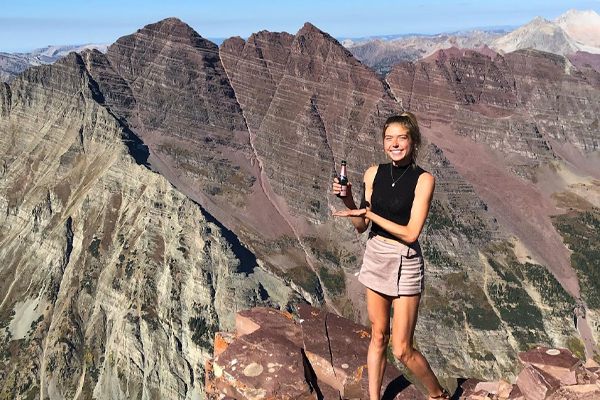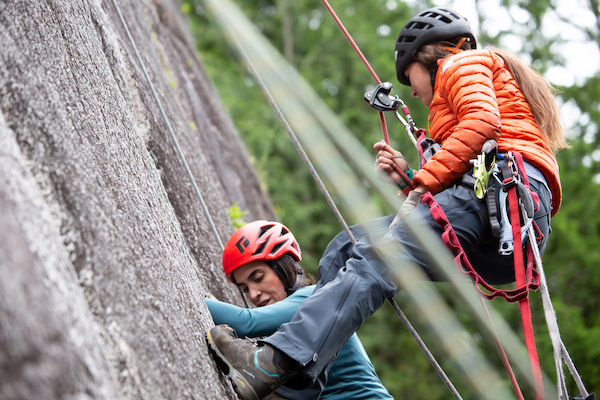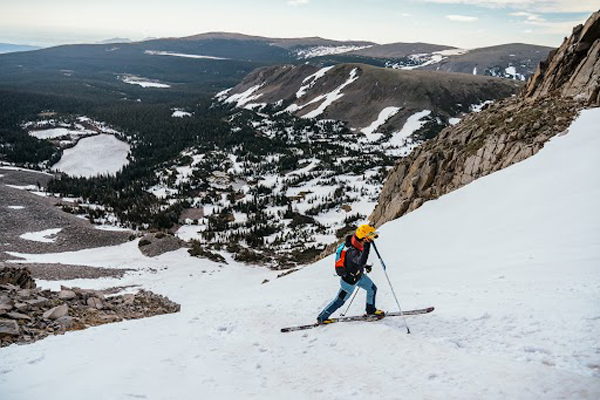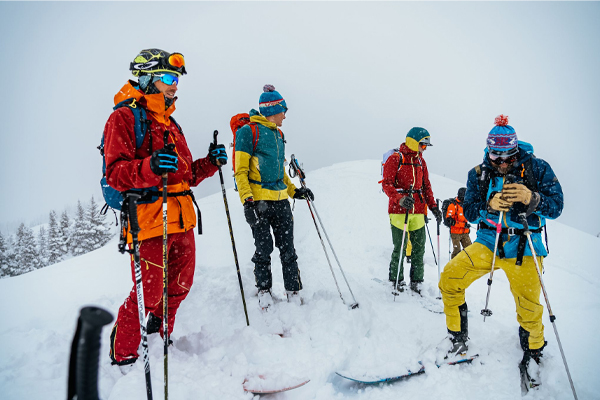Anton Krupicka - Looking Back at Leadville 2006

Running Leadville in 2006 finally validated my unparalleled love of logging miles. I’d found my niche...
- - -
I had never intended to run the Leadville 100 in the summer of 2006. For a runner in Colorado Springs (I went to undergrad at Colorado College), the Pikes Peak Marathon (PPM) is the be-all end-all, but my autumnal obligations as a collegiate cross-country runner had always precluded me from participating. Too abusive, too much recovery required, coach’s orders. After five years of anticipation, in my first summer out of college I was champing at the bit to see how I measured up on the PPM’s most classic and purest of courses.
Circumstances had other ideas. In the first half of the summer I’d won the Estes Park Marathon and Leadville Marathon and used my victory in the latter as argumentative proof that I deserved an entry into the PPM (entries are typically awarded via a massively over-subscribed lottery, but a few spots are held aside each year to ensure a competitive field). In my transition from student to staff at Colorado College that summer, however, email communication was compromised and I didn’t own a phone. In this confusion, I didn’t hear back from the organization (eventually I found out that I had, in fact, been granted an entry to the PPM, but it was through the grapevine after the race) and I just assumed that the race committee had deemed me unworthy. What to do?
As was my wont at the time, I’d spent the summer logging fairly massive running volume. I had just begun my job as a para-professional tutor at the campus Writing Center, so sitting behind a desk eight hours a day during the slow summer months allowed for plenty of day-time recovery. Most days were a three-hour mountain run in the morning paired with a 40 to 60-minute jog on flat trails with friends in the evenings. Nearly every weekend we escaped to the central mountains of Colorado—the Elks, the Sawatch—for high altitude camping and long run adventuring.
I was fit, and Colorado Running Company manager John O’Neill observed as much: “Dude, you’re running 200 miles a week, you’re never going to be more prepared for this, just run Leadville.” John has a penchant for delivering unvarnished truths, tact be damned—of course, he wasn’t wrong. I had plenty of experience with running long distances—my first marathon at age 12 and a few more since; a handful of 30+ mile training runs over the years, simply out of curiosity—but if I ran Leadville it would be my first official ultra, and, of course, the farthest I’d ever run. I suppose that was kind of the point.
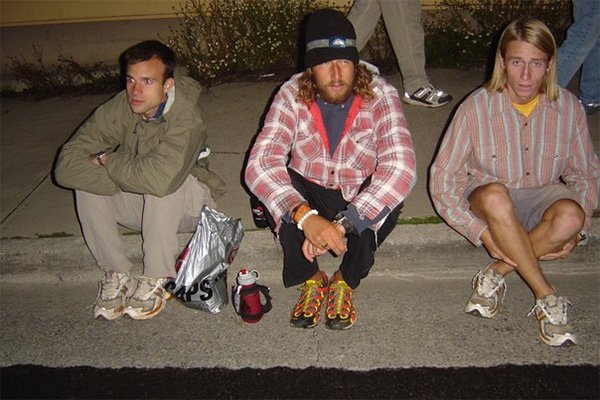
Awaiting the 4am start at the 2006 LT100 with crew-pacers Julian Boggs and Alex Nichols
But the Leadville 100 was on a bit of a pedestal in my mind. It was THE classic Colorado ultrarunning challenge. The previous summer my adolescent running hero—Manitou Springs denizen and Pikes Peak legend Matt Carpenter—had shattered the Leadville course record, running nearly a minute per mile faster than anyone else ever had at the race. This performance had cemented Matt’s superhuman status in my mind, but it also served to further elevate the aura of the event itself for me. I knew it was mandatory that I attempt Leadville one year, I just didn’t think it would be that year.
Three weeks out from race day I needed to make a decision, so my friends and I headed up to the upper Arkansas River valley yet again. They dropped me off in Leadville at the corner of Harrison and 6th with a water bottle and 10 gels and set off for a day of mountain biking, agreeing to pick me up in Winfield that afternoon, 50 miles of trails and mountain passes away. I’d printed out the course description on a piece of paper folded in my pocket as my only guide.

Sugarloaf (outbound)
It went surprisingly well. Other than some minor confusion around the Twin Lakes river crossing at mile 40, I pretty much nailed the onsight of the course, and 7:26 later found myself jogging into the mining ghost town that serves as the race’s turnaround point. I only ate seven of the gels and refilled my water bottle twice. It fit the life-long pattern in my running that, the farther I went, the more natural a high-quality effort felt to me.
The run left me simultaneously buoyed and dismayed. I was giddy at having just covered every inch of Leadville’s storied out-n-back track and completing my longest run ever in the process—nine minutes under Matt’s course record pace, no less—but, as such, my legs felt destroyed and the thought of turning around and running all the way back to Leadville was virtually incomprehensible.
Notes from my training log entry that day:
"I feel that if I slow it down up and over Hope Pass and get to half-way right at 8hr or a little bit under, drink more water, and maybe eat more food, then I might be able to turn around and finish this fucking race."
The next day, I ran 4hr from the Sugarloaf Dam, around Turquoise Lake, up and over Sugarloaf Pass, and back to the Dam for a back-to-back long run weekend of 80 miles on the course. I had heard this was the kind of thing ultrarunners do. It also came at the end of a 222-mile week. Although GPS watches and apps were barely invented let alone in vogue at the time, I had measured most of the trails around Colorado Springs over the years with a mountain bike (using an old school computer that was based on the wheel’s revolutions), so even if I was overestimating my mileage by, say, 10%, it was still outrageous. It gave me enough confidence to mail in my $200 entry fee.
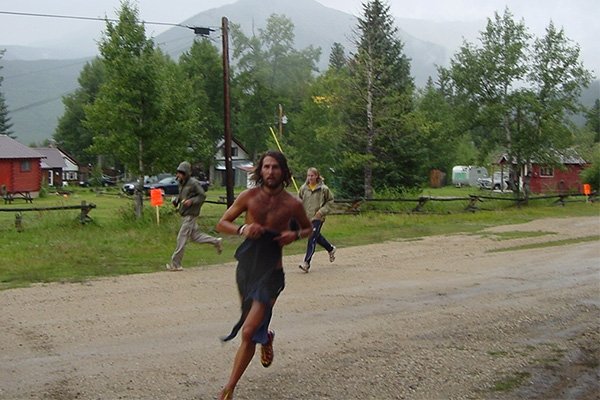
Coming into the Twin Lakes Aid Station (outbound) at mile 40
Now, 12 years later, with a little more perspective and perhaps at least a modicum of maturity, I locate the motivation for this kind of irrational training as being a potent mix of arrogance and insecurity. I always felt that I lacked talent as a runner, so I needed to compensate with an obscene workload. Why wasn’t anyone else doing this? Well, they were lazy, of course. To be sure, I simply enjoyed the act of running, too. I don’t think that kind of volume can be fueled on pure hate alone.
The next weekend—two weeks out from race day—was perhaps even more ambitious. On Saturday I performed a training run that I knew my assistant cross-country coach, Paul Koch, had done in preparation for his run at Leadville ten years previous. Starting from my apartment in downtown Colorado Springs I ran through the Garden of the Gods to Manitou Springs, then up and down Pikes Peak via the Barr Trail, and back home through the Garden again. Basically, a PPM with a 12-mile warm-up and cooldown for another 50-mile day.
I was happy with how good I felt after this run later in the day—not as crushed as the previous week—but my training log notes reveal that maybe I thought I perhaps wasn’t trying hard enough. To wit:
"My barr camp to the top split was slower than I would've liked. I guess I could've definitely gone harder. Actually, I know I could've because I was never anaerobic, and when I was descending I saw Galen Burrell going up and he was anaerobic as fuck—puffing like a steam engine."
Galen would go on to finish 2nd behind Carpenter at that year’s PPM.
Sunday morning, I eschewed my approach-by-foot and “only” ran a PPM, driving to the starting line in Manitou Springs. On this day, the day after a 50-mile run, I actually PR’ed (at the time) for the Pikes Peak Ascent in 2:37 and did the roundtrip in 4:15. Of note in this training log entry was this nugget at the end:
"My Sportivas (especially the right one) are getting pretty thin. Great Run!"
In 2006—three years before Christopher McDougall’s NYT-bestseller Born to Run was published and Hollywood celebrities were subsequently photographed wearing Vibram FiveFingers—I was in the midst of my fascination with minimal footwear and barefoot running. I’d raced the Leadville Marathon earlier that summer in a pair of very thin Puma XC racing waffles—no midsole at all—but had, unsurprisingly, bruised my right forefoot on the course’s blown up, rocky mining roads.
As such, after the race I went into the Colorado Running Company looking for the most minimal trail running shoe on the wall; something that would offer just a little more protection than a racing waffle. That shoe was the La Sportiva Slingshot—a classic from their nascent Mountain Running line that laced to the toes like an approach shoe and had a meager 5mm of sheet EVA for a midsole with another 5mm wedge under the heel, making it a departure from the 10-12mm of heel-to-toe drop that was standard in running shoes at the time.
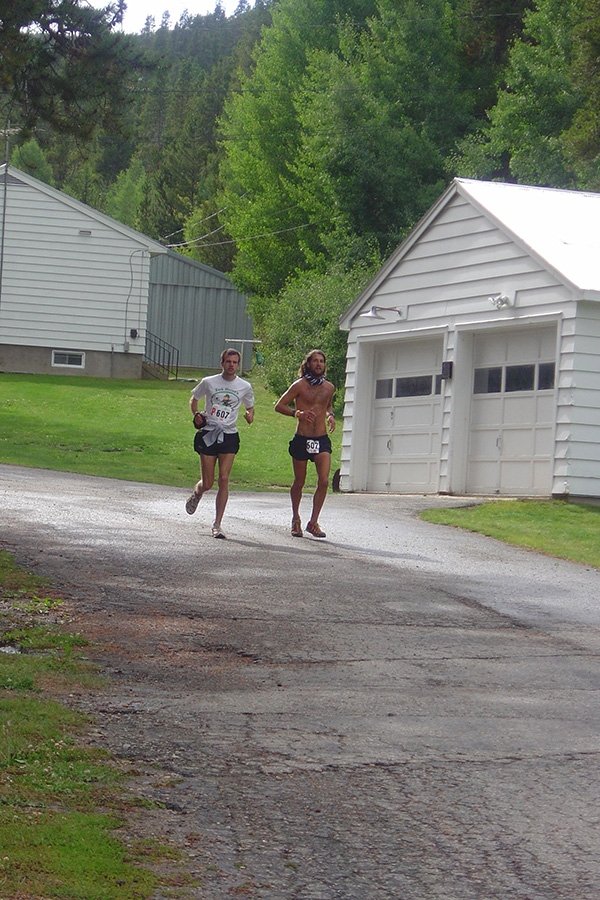
Mile 76: Leaving Fish Hatchery (inbound) with Julian pacing
That was still too much for me, though, so upon purchase I went home, immediately removed the insole (of course), brandished my trusty bread knife that I’d already applied to many a road racing flat, and carefully carved off the offending material in the heel, leaving the back half of my outsoles as exposed EVA, but giving me a zero-drop ride. Perfect. In preparation for the race, I purchased and carved a fresh pair of Slingshots, only doing a couple shake-out runs in them the week of the race to ensure optimal performance over the 100-mile distance.
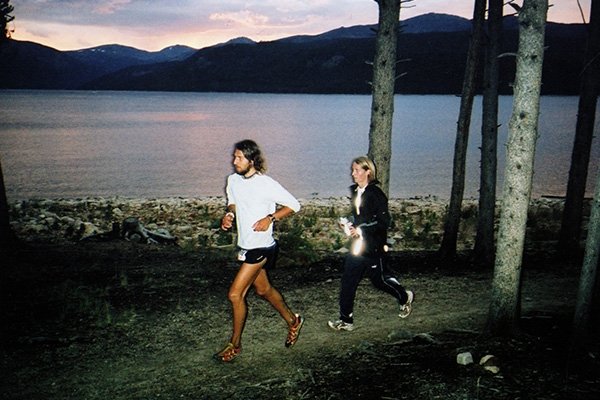
Mile 93: Turquoise Lake (inbound) with Alex pacing
Looking back, I don’t find the race itself that remarkable. When you’re regularly running 30 hours per week in training, 100 miles comes pretty naturally. I ran in the lead after only five miles and pulled away to run by myself at the 15-mile mark, extending my margin of victory to almost two hours by the finish, over five-time champ and Leadville legend Steve Peterson. I had toed the line with the intention of winning and breaking 17 hours. With my 17:01 finishing time, in the history of the event, I ended up only being slower than Matt’s paradigm-shattering course-record run the year before.
Most important, I think, was leveraging my aforementioned arrogance and insecurity with a concomitant coupling of ignorance and inexperience. I had no preconceived notions to limit myself. I had no indoctrination from the community about acceptable practices. So, I just did my usual thing—go running in the mountains, carry only what you need and nothing more. It turns out this was just a lot less than most people were comfortable with. A pair of shoes, a pair of shorts, a bottle, and a handful of gels were all it really took.
This naiveté was paradoxically empowering and was the magical thing about being a newcomer in the sport. It allowed for unfettered thinking and perhaps unreasonable expectations that I found myself meeting simply because I didn’t know any better. Up until the Leadville 100 in my competitive running career, all of my passion and effort in training had largely resulted in disappointment. Based on race results (albeit not the only metric of value, of course), what I was putting into the sport was embarrassingly disproportional to what I was getting out of it. At the age of 23, I’d already been a dedicated runner for over half my life, and Leadville was finally this validating experience for my unparalleled love of logging miles. I’d found my niche.
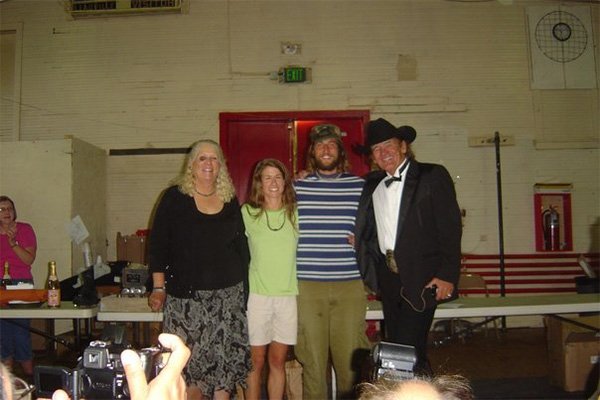
Awards with Ken Merilee and Diana Finkel
The week after Leadville I got an email from Buzz Burrell—Galen’s father, and manager of the La Sportiva Mountain Running® Team at the time. It was extremely short and to the point:
“Nice job at Leadville. I saw you were wearing Sportivas. Want some for free?”
This was my first experience with Buzz’s no-nonsense approach, that I now know extends to pretty much everything. La Sportiva became my very first sponsorship in the outdoor industry and Buzz became a good and continuing friend.
More than launching a career in the outdoor industry, however, the 2006 Leadville 100 opened my eyes to the possibilities of what I was capable of in the mountains. After running 100 miles for the first time, suddenly almost anything seemed possible. It was the spark for a sense of confidence and aptitude that persists to this day, warranted or not.
Now all I have to do is get around to actually racing the Pikes Peak Marathon. Maybe next year.
Photos provided by Anton Krupicka.
- - -
ABOUT THE AUTHOR
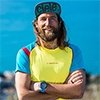 ANTON KRUPICKA is a member of the La Sportiva Mountain Running® Team.
ANTON KRUPICKA is a member of the La Sportiva Mountain Running® Team.
- - -



